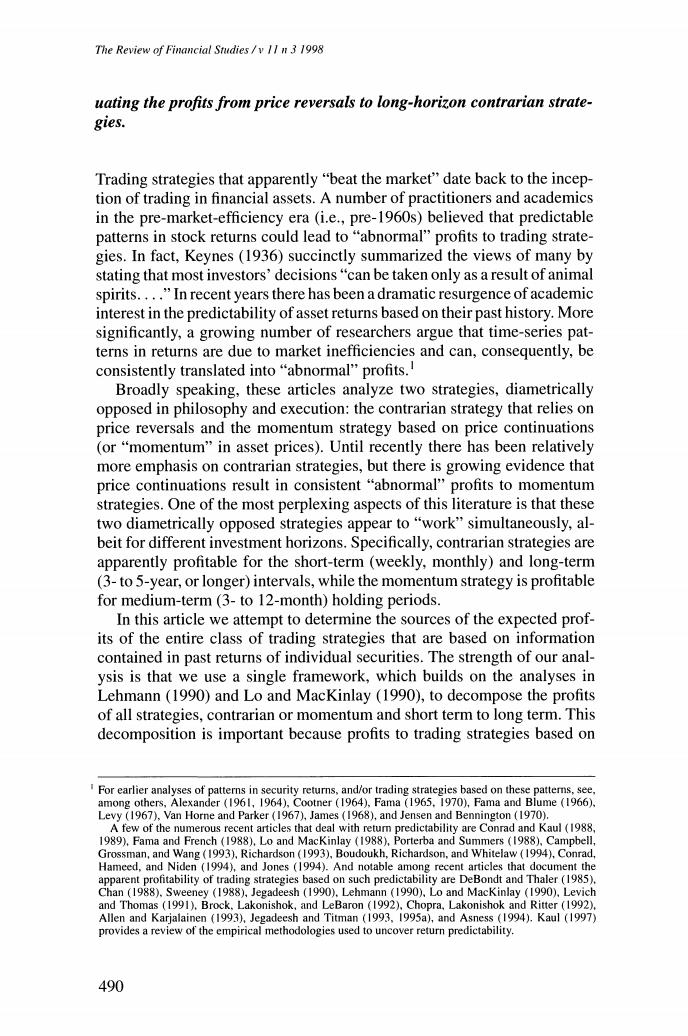正在加载图片...

The Review of Financial Studies /v 11 n 3 1998 uating the profits from price reversals to long-horizon contrarian strate- gies. Trading strategies that apparently"beat the market"date back to the incep- tion of trading in financial assets.A number of practitioners and academics in the pre-market-efficiency era (i.e.,pre-1960s)believed that predictable patterns in stock returns could lead to"abnormal"profits to trading strate- gies.In fact,Keynes(1936)succinctly summarized the views of many by stating that most investors'decisions"can be taken only as a result of animal spirits...."In recent years there has been a dramatic resurgence of academic interest in the predictability of asset returns based on their past history.More significantly,a growing number of researchers argue that time-series pat- terns in returns are due to market inefficiencies and can,consequently,be consistently translated into"abnormal"profits. Broadly speaking,these articles analyze two strategies,diametrically opposed in philosophy and execution:the contrarian strategy that relies on price reversals and the momentum strategy based on price continuations (or"momentum"in asset prices).Until recently there has been relatively more emphasis on contrarian strategies,but there is growing evidence that price continuations result in consistent "abnormal"profits to momentum strategies.One of the most perplexing aspects of this literature is that these two diametrically opposed strategies appear to"work"simultaneously,al- beit for different investment horizons.Specifically,contrarian strategies are apparently profitable for the short-term (weekly,monthly)and long-term (3-to 5-year,or longer)intervals,while the momentum strategy is profitable for medium-term (3-to 12-month)holding periods. In this article we attempt to determine the sources of the expected prof- its of the entire class of trading strategies that are based on information contained in past returns of individual securities.The strength of our anal- ysis is that we use a single framework,which builds on the analyses in Lehmann (1990)and Lo and MacKinlay (1990),to decompose the profits of all strategies,contrarian or momentum and short term to long term.This decomposition is important because profits to trading strategies based on For earlier analyses of patterns in security returns,and/or trading strategies based on these patters,see among others,Alexander (1961,1964),Cootner (1964),Fama (1965.1970),Fama and Blume (1966), Levy (1967),Van Horne and Parker (1967),James (1968),and Jensen and Bennington (1970). A few of the numerous recent articles that deal with retum predictability are Conrad and Kaul (1988 1989).Fama and French(1988).Lo and MacKinlay (1988),Porterba and Summers (1988).Campbell, Grossman,and Wang(1993),Richardson(1993),Boudoukh,Richardson,and Whitelaw (1994),Conrad, Hameed,and Niden (1994),and Jones (1994).And notable among recent articles that document the apparent profitability of trading strategies based on such predictability are DeBondt and Thaler(1985). Chan (1988).Sweeney (1988).Jegadeesh (1990).Lehmann (1990).Lo and MacKinlay (1990).Levich and Thomas (1991).Brock,Lakonishok,and LeBaron (1992).Chopra,Lakonishok and Ritter(1992), Allen and Karjalainen (1993),Jegadeesh and Titman (1993,1995a),and Asness (1994).Kaul (1997) provides a review of the empirical methodologies used to uncover return predictability. 490